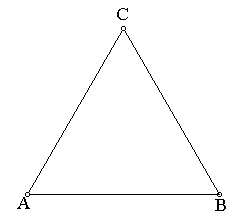
The Chaos Game is played as follows:
On a sheet of paper, mark the three vertices of an equilateral triangle. (Variations of the game use triangles of other shapes.) Mark the vertices A, B and C, as shown below.

With a pencil or pen, mark any other point chosen at random on the paper. We will call this point P. You should mark the point, but don't label it. Now roll an ordinary 6-faced die. If the die comes up 1 or 2, measure half the distance from P to vertex A, and plot a new point there. (Remember where this point is, but don't label it.) If the die shows 3 or 4, do the same thing, but instead go half the distance toward vertex B. If the die shows 5 or 6, go halfway to vertex C. Continue this process, using your newly marked points as the new starting points for each move. Play for about 30,000 moves or until you get tired -- whichever comes later.
The Chaos Game
It seems intuitively clear that "chaos" would be a good word to describe this game. After all, you are marking 30,000 points, each of which is selected by applying a random process -- the roll of a die. And each game should progress differently, since there is randomness involved in each move. After 30 rolls of the die in one play of the game, the following points were plotted:
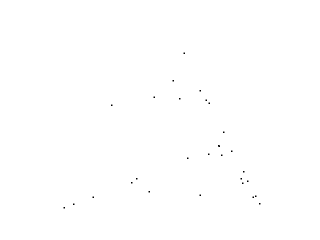
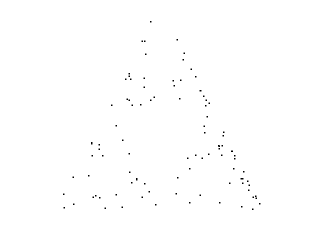
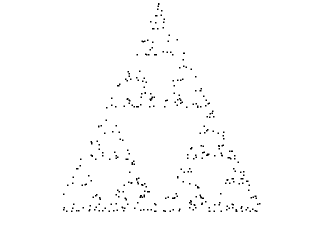
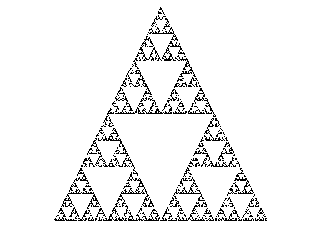
Order in Chaos
One of the strange allures of mathematics is that it often happens that there is an eerie kind of order lurking just behind the scene in what at first appears to be chaos! In this particular case, however, it is not that difficult to believe that the chaos game should indeed give rise to the Sierpinski gasket. Let's denote the Sierpinski gasket by the letter S. If we start with a point P that just happens to be one of the points in S, then the next point (which is halfway toward one of the vertices) will also be in S. (This can be proven algebraically, but it is easy to convince yourself from the picture that this will be the case. Just try it with a few of the points shown in S above.) So in the case that we happened to start with a point in S, then the next 30,000 points plotted will also be in S.
On the other hand, if we start with a point P that is not
in S, then none of the 30,000 points plotted will actually
be in S! (Try this by looking at a point P that is in the
large omitted triangle in the middle of the picture above. If we
move halfway toward a vertex, we will be in the next-smaller-sized omitted
triangle that is closer to that vertex. And that pattern of not
being
in S will continue indefinitely.) However, with each roll of the
die, the point plotted is closer to some point in S. Specifically,
if the initial point P is a distance d from the closest point
in S, then after the next roll, our distance from some point of
S
will be d/2. Since the distance from S is halved with each
roll, it follows that after only 10 rolls, our distance from some point
in S will be ![]() ,
which is less than
,
which is less than ![]() ,
and after 30 rolls, the distance from S is
,
and after 30 rolls, the distance from S is ![]() ,
a distance which is imperceptible on even the highest resolution display
device. Thus, after a relatively small number of rolls, it appears
that all of the remaining points are in S. So the Chaos Game
may not always draw a picture of S, but it will at least always
give a good forgery! To make the forgery even better, we simply omit
the first 30 points when drawing the final picture.
,
a distance which is imperceptible on even the highest resolution display
device. Thus, after a relatively small number of rolls, it appears
that all of the remaining points are in S. So the Chaos Game
may not always draw a picture of S, but it will at least always
give a good forgery! To make the forgery even better, we simply omit
the first 30 points when drawing the final picture.
Variations of the Chaos Game
The process of moving half the distance to a vertex can be accomplished
by applying a transformation of the plane. In order to obtain algebraic
formulas for the three transformations used in the Chaos Game, let's place
the lower left vertex A at the origin of the plane. If the
coordinates of the point P are ![]() ,
then the point that is half the distance toward A will be
,
then the point that is half the distance toward A will be ![]() .
Mathematically, we can express this process as a transformation of the
plane:
.
Mathematically, we can express this process as a transformation of the
plane: ![]() .
The transformations T2 and T3 corresponding
to the other two moves in the Chaos Game can be expressed by similar formulas.
The Chaos Game is played mathematically by (many times) randomly selecting
one of T1, T2 or T3
and applying it to the previously plotted point.
.
The transformations T2 and T3 corresponding
to the other two moves in the Chaos Game can be expressed by similar formulas.
The Chaos Game is played mathematically by (many times) randomly selecting
one of T1, T2 or T3
and applying it to the previously plotted point.
We can vary the Chaos Game mathematically by varying the transformations.
This is much, much easier than inventing a geometric interpretation of
each new variation! The only stipulation is that the transformations
must be based on linear processes, and must reduce distances.
The discovery that these two conditions will guarantee a bounded picture
as a result is actually quite recent, dating back only 15 years or so.
The underlying mathematics belongs to an emerging field known as fractal
geometry. A few examples of the kinds of images that can result
from such variations of the Chaos Game are shown below. You can click
on each of the thumbnail images to get a larger version. Some of
these images have been designed to resemble things found in nature.
 |
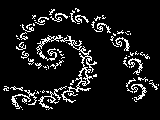 |
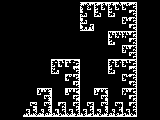 |
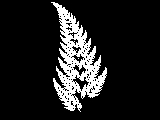 |
Further Exploration